Flower farming involves many repetitive activities such as bending, pulling, twisting and carrying. Repetitive motions can cause stress and strain on the body, and in particular the soft tissues such as tendons, muscles, and ligaments. Pain can occur anywhere, but common sites may be neck and back, knees, wrists, and shoulders.
Prevention
Early identification of the problem can help to prevent a minor ache or pain or injury from becoming a bigger issue in the future. One way to combat an issue early on, is through activity modification. Activity modification means to change or adjust how a particular activity or task is being completed. This can include minimizing time spent in sustained postures, changing positions frequently, taking more frequent breaks, intermittent stretching, changing tasks, and using proper tools. For instance, it may be better to use a kneeling pad in order to get close to the ground to weed, rather than bending over at the waist and reaching for the ground. Other examples may include: making sure tools are sharp to prevent overuse, using stools or steps to assist in reaching to prevent overextending, and changing from a kneeling to a sitting position.
When moving loads, these are some things to keep in mind to keep yourself safe. In general, pushing-type activities are safer than pulling-type activities. Use tools and help from other people for lifting and moving. For instance, using a cart or wagon to move a load from one place to another is much less stressful on the body when compared to carrying it alone. Using a helper to move heavy and/or awkward shaped items will greatly decrease the work. Sometimes this may take a bit more planning (such as moving objects only when someone is available to help) or time, but in the end could save you oodles of time that could be lost due to an injury.
In addition, using proper lifting mechanics can save your back from a serious injury. This includes squatting down to the load and lifting with your legs versus bending at your waist and lifting from your back. Other tips include: keeping the load close to your body, creating a shorter lever arm, and moving your body as one versus twisting (do not keep feet in one place and rotate your body while holding a load).
Simple Stretches
There are some simple stretches that can be done anywhere, without any equipment to help combat the stress and strain that may result from work activities. These stretches shown below can be done as a warm-up prior to starting work, and/or throughout the day. The stretches should be gentle and not forced. Forcing through a stretch can result in injury. If you have a history of injury, surgery or other concern, consult a medical professional before adding to your routine.
Hands, Wrists, and Arms
These are two stretches for the muscles in the forearm that extend and flex the wrist. The forearm muscles are very active in weeding, pruning and many other activities. Hold each position for 20-30 seconds, 2x on each side. This one is easy to do throughout the day after repetitive activity.
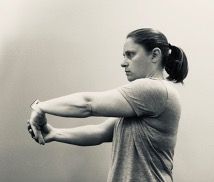
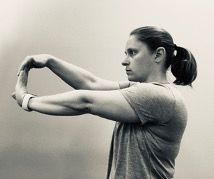
Back and Hips
This is a stretch for the low back and hips. Begin on all fours in a crawling position and then flex and extend through the low back and hips. Movements should be gentle and controlled. Reverse positions approximately 10 times.
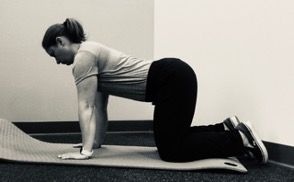
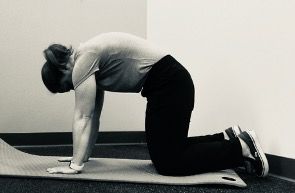
This is a stretch for hip flexors that likely feel tight after a lot of bending and squatting. Stand in a split stance position and then slowly shift your weight forward so that you feel a stretch on the front of your hips (the leg that is behind should feel the stretch).
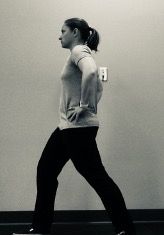
Chest & Shoulders
Below are two stretches for the chest and shoulders. In the first one clasp your hands together behind your back and then slowly pull away from your body. Hold this for 20 seconds. Keep breathing gently as you stretch. Do not hold your breath. For the second stretch, begin with your hands extended in front of you and then open the arms wide to get a nice stretch across your chest and shoulders. Hold for a couple seconds and repeat five times. This is a nice one that can be completed anywhere.
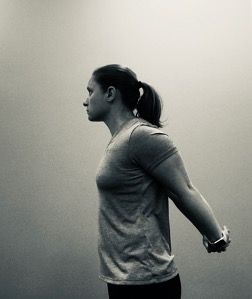
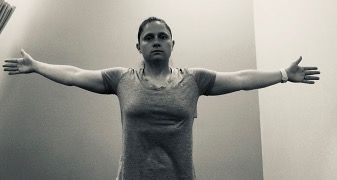
Lower Body
This is a stretch for hamstrings that also can feel tight after lots of squatting. Be sure to bend at your hips rather than through your back. Keep the knee straight of the leg you are stretching. You should feel the stretch down the back of your leg. The hip flexor stretch above and the hamstring stretch below can both be done for 30-60 seconds and on both sides, preferably two times on each side. Remember to breath as you stretch.
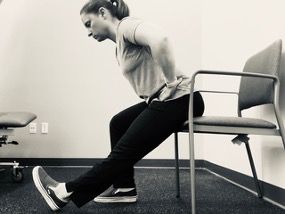
The following is a movement to help moves into more extension-based movements as we tend to use our flexor muscle groups much more frequently than our extensor muscle groups. To start this exercise, you begin in a crawling position with your back in neutral, hands under your shoulders and knees under hips. Then extend back one leg and reach forward with opposite arm. Make yourself long, versus reaching toward the ceiling. Hold this position for 1-2 seconds and then repeat with opposite side. Complete 10-12 reps on each side.
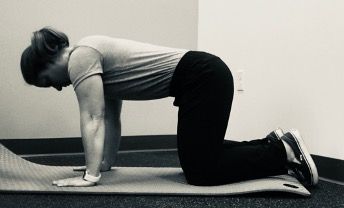
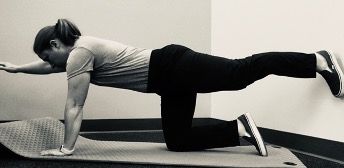
Wrapping Up
Please note that the focus of this article was to introduce some simple stretches that can be completed nearly anywhere. There are also many variations of strengthening exercises that can be done to further combat injury, using simple bands and body weight. However, that would be beyond the scope of this article. It is always best to consult an MD or PT before starting any new exercise program.
Categories
About the Author
Erin Bembry, PT, DPT
Erin is a physical therapist that lives in Seattle, WA with her husband and two children. She is a graduate of the University of Washington Physical Therapy program. She works in an orthopedic outpatient setting working with clients that have all types of injuries and chronic pain conditions. Erin competed in the 1998 and 2002 Olympic short track speedskating teams and was a member of the United States National speedskating team for 10 years. She has been active in sports her entire life and continues to be active with her family, coaching soccer, hiking, paddle boarding, and enjoying the outdoors of the PNW.
